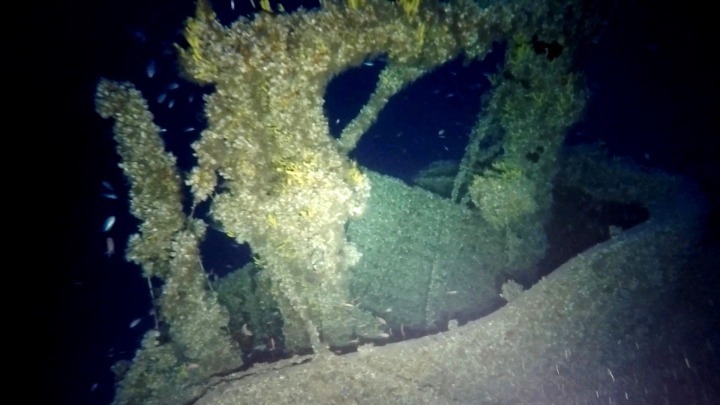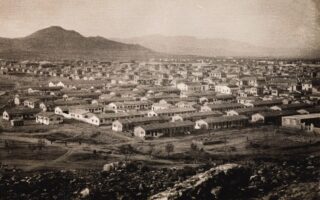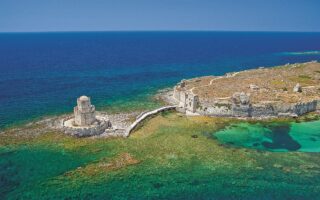Greek diver discovers long-lost British World War II submarine

A prominent Greek diver and researcher announced on Wednesday he had discovered the lost British submarine HMS Triumph, whose true fate had been shrouded in mystery ever since the vessel and its entire crew disappeared in 1942.
The submarine had disappeared without a trace, with all 64 crew members on board, some 81 years earlier, in the midst of World War II. Various attempts to find it had been mounted at various times by teams from the United Kingdom, Malta and Russia, all without success.
The wreckage was discovered on the seabed by Greek diver Kostas Thoctarides and his team, after a search lasting roughly 25 years. “It was the hardest and most expensive mission I have ever carried out in my life,” Thoctarides told the state-run Athens-Macedonian News Agency (AMNA). “The history of the submarine is multifaceted and unique in naval chronicles, as it is inseparably connected with the national resistance and secret services of the time, which operated during the occupation,” he said.
The key to unlocking the secret that had remained hidden for more than eight decades, he said, was “research using primary historical sources. There had to be an extensive study of the archives, both in the UK and in Germany, as well as in Italy and in Greece.”
It lies with an eight-degree starboard list, dozens of kilometers from the shore. The periscopes and hatches are down, indicating that it was in a deep dive during its last moments, while its depth and directional rudders indicate that it was moving at a steady depth, the diver explained. On its turret are the wooden helm, compass and a four-inch cannon that is slightly raised. The hatches on either side of the cannon leading to the interior are also shut. On the fore side of the bridge, the door leading to the gunnery is open, all hatches are closed. The right torpedo tube has opened and an MK VIII torpedo is half-out of the submarine.
The submarine appears to have sunk due to a powerful explosion in the fore section but the cause of the explosion is still unclear. “Our research continues, chiefly on a historical level as new evidence and facts come to light, which combined with the information that we now have from the wreck and the assistance of naval experts specializing in submarines and torpedoes will unlock the secrets of the HMS Triumph,” Thoctarides said, who described the site as “a watery grave for 64 heroes that inspires awe.”
The history
First launched in 1938, the Triumph joined the war in earnest in May 1939 and carried out 20 military missions in total. It first sailed to the Aegean at the end of March 1941 to scout the shores of the Dodecanese islands and land officers on Greek shores. She notched up a number of successes, sinking a large number of enemy ships, including the Italian submarine Salpa. She also undertook difficult missions to land Special Operations Executives (SOE) and MI9 agents and rescue trapped soldiers who needed to escape to Alexandria in Egypt.
On December 26, 1941 the Triumph would set sail from Alexandria for its 21st and last mission before it was due to return to England for a general repair and maintenance. It had orders to carry out two special operations and, in the meantime, to patrol the specific section of the Aegean.
On board the vessel were some very unusual crew members – SOE and MI9 Agent, Lieutenant George Atkinson, Greek SOE wireless expert, Diamantes Arvanitopoulos (codename DIAMOND), New Zealand liaison officer, Captain Craig, two British Army commandos from the Northamptonshire Regiment and Royal Artillery and five tons of emergency supplies. Atkinson’s mission (codename ISINGLASS) was to meet up with a Greek resistance cell in Athens and then liberate 18 selected Allied soldiers who had been held prisoner by the Italians.
Atkinson carried substantial quantities of money in cash and gold coins, destined as MI9 and SOE assistance to specific individuals in occupied Athens, as well as two sets of radio transmitters for communication with Cairo. Captain Craig was in charge of the second secret mission codenamed “Coney Island,” which was to coordinate the liberation of 30 British fugitives who were on the island of Antiparos.
In Atkinson’s pocket was his Operation paper with typed heading “Not To Be Taken Ashore.” With his mission complicated by dual SOE & MI9 instructions, he was to overlook this warning.
During the night between December 29 and December 30, 1941 the Triumph sailed into the bay of Despotikos, where it let off the special team and supplies. The captain, John S. Huddart, told the 30 fugitives that he had orders to carry out a patrol of the Aegean and would return to collect them on January 9-10 in order to take them to Alexandria. He also radioed the successful conclusion of the first leg of the mission. This was the last communication ever received from the vessel.
All members of the SOE team were arrested on Antiparos and Atkinson’s Operation paper, which contained the names of 37 members of the Greek resistance in Athens, with their aliases and code numbers, fell into enemy hands. The information was passed on to German authorities and all 37 were rounded up and executed, along with Atkinson. The others were taken to concentration camps.
The Triumph continued its patrol, making its presence felt near the islands of Milos and Naxos. On January 9, 1942 at 11.45 a.m. it attacked the cement freighter Rea as it was being towed by the vessel Taxiarchis south of Sounio, with the torpedo exploding on the rocks.
“Recently, in the same part of the deep, we identified another three British Mk VIII torpedoes of the same type as that carried by the Triumph … this fact makes us believe that the Triumph launched more than one torpedo during its last attack,” Thoctarides said.
The last time the submarine was sighted in motion was by an Italian pilot flying in the area, about four nautical miles southeast of Sounio, he added, noting that this hitherto lost piece of information helped complete the puzzle of the submarine’s history. After this, all traces of the vessel disappear and on January 23, 1942 the British Admiralty declared that the submarine must be considered lost, all hands. [AMNA]





